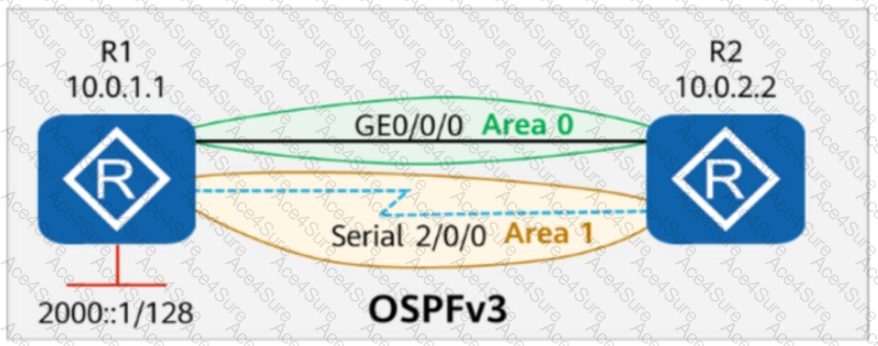Comprehensive and Detailed In-Depth Explanation:To determine which LSAs are available in Area 0, we need to analyze the OSPFv3 network, the area types, and the behavior of external routes in an NSSA, considering the possibility of multiple correct answers. Let’s break it down step by step:
Understanding the Network and Area Types:
The network has two areas: Area 0 (backbone area) and Area 1 (Not-So-Stubby Area or NSSA).
R1, located in Area 1, imports an external IPv6 route (2000::1/128) into OSPFv3.
Area 0 is the backbone area, and Area 1 is an NSSA, which allows limited external routes but has specific restrictions on LSA types.
OSPFv3 LSA Types and Their Roles:
Link-LSA (Type 8): These are link-local LSAs, flooded only within the local link and not propagated beyond the local segment. They are not flooded into Area 0 or other areas, so they are not relevant for inter-area or external route advertisement.
Inter-Area-Router-LSA (Type 4): These LSAs are used to describe routers in other areas, specifically Autonomous System Boundary Routers (ASBRs) that originate external routes. In this case, R1 is an ASBR in Area 1 (NSSA) importing the external route 2000::1/128. Type 4 LSAs are generated by the ABR (e.g., R1 or another router connecting Area 1 to Area 0) and flooded into Area 0 to provide reachability information to the ASBR (R1) for the external route. Therefore, Inter-Area-Router-LSAs can be present in Area 0 to help routers reach R1 as the ASBR.
Intra-Area-Prefix-LSA (Type 9): These LSAs advertise prefixes associated with routers or transit networks within the same area. They are not used for external routes and are confined to Area 1, so they are not available in Area 0.
Inter-Area-Prefix-LSA (Type 3): These LSAs advertise prefixes from one area to another, including routes summarized or redistributed into the OSPF domain. In an NSSA, external routes (like 2000::1/128) are advertised as Type 7 LSAs within Area 1. The ABR (e.g., R1 or another router) translates these Type 7 LSAs into Type 5 LSAs or, in OSPFv3, they may be represented as Inter-Area-Prefix-LSAs (Type 3) to flood the external route into Area 0. Thus, Inter-Area-Prefix-LSAs are available in Area 0 for the external route 2000::1/128.
Behavior of External Routes in an NSSA:
In OSPFv3, an NSSA (like Area 1) allows external routes to be imported by an ASBR (R1 in this case). NSSAs do not flood Type 5 LSAs (external LSAs) directly into the area. Instead, external routes are advertised as Type 7 LSAs within the NSSA.
The Area Border Router (ABR) connecting the NSSA (Area 1) to the backbone (Area 0)—likely R1 or another router—translates the Type 7 LSAs into Type 5 LSAs (or, in OSPFv3, they may be represented as Inter-Area-Prefix-LSAs or other appropriate LSAs for external routes). These translated LSAs are then flooded into Area 0.
Additionally, since R1 is an ASBR, Area 0 needs to know how to reach R1 to access the external route 2000::1/128. This is achieved through Inter-Area-Router-LSAs (Type 4), which are flooded into Area 0 by the ABR to describe the location of the ASBR (R1) in Area 1.
Determining LSAs Available in Area 0:
Link-LSA (Type 8): These are link-local and not flooded into Area 0, so they are not available in Area 0.
Inter-Area-Router-LSA (Type 4): Since R1 is an ASBR in Area 1 (NSSA) importing the external route, the ABR (e.g., R1 or another router) generates Inter-Area-Router-LSAs to advertise R1’s location to Area 0. This LSA is necessary for routers in Area 0 to reach the ASBR (R1) for the external route 2000::1/128. Therefore, Inter-Area-Router-LSAs are available in Area 0.
Intra-Area-Prefix-LSA (Type 9): These are confined to Area 1 and not flooded into Area 0, so they are not available in Area 0.
Inter-Area-Prefix-LSA (Type 3): This LSA is used to advertise the external prefix 2000::1/128 into Area 0 after translation from Type 7 LSAs in Area 1. Therefore, Inter-Area-Prefix-LSAs are available in Area 0.
Conclusion:
The external route 2000::1/128, imported by R1 in Area 1 (NSSA), results in both Inter-Area-Router-LSAs (Type 4) and Inter-Area-Prefix-LSAs (Type 3) being available in Area 0.
Inter-Area-Router-LSA (Type 4) is present to describe the location of the ASBR (R1) in Area 1, allowing routers in Area 0 to reach R1 for the external route.
Inter-Area-Prefix-LSA (Type 3) is present to advertise the external prefix 2000::1/128 into Area 0 after translation from the Type 7 LSA in Area 1.
Therefore, the correct answers are B (Inter-Area-Router-LSA) and D (Inter-Area-Prefix-LSA).
OSPFv3 LSA Types: HCIP-Datacom documentation on OSPFv3 LSAs, including Link-LSA, Inter-Area-Router-LSA, Intra-Area-Prefix-LSA, and Inter-Area-Prefix-LSA (e.g., Section on OSPFv3 Fundamentals).
NSSA Behavior in OSPFv3: HCIP-Datacom coverage of NSSA areas, Type 7 LSAs, and their translation to Type 5 or Inter-Area-Prefix-LSAs for Area 0, as well as Inter-Area-Router-LSAs for ASBR reachability (e.g., Chapter on OSPFv3 Advanced Features and Area Types).
External Route Propagation: HCIP-Datacom explanation of external route handling in OSPFv3, including ASBR and ABR roles, and LSA types for inter-area and external route advertisement (e.g., Section on Route Redistribution and IPv6 OSPF).

